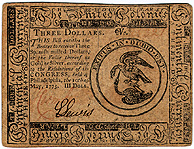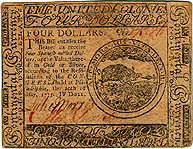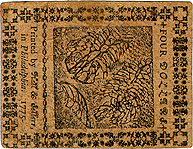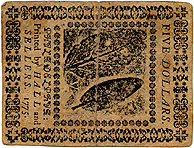Continental Currency
May 10, 1775
An emission totaling $3,000,000 payable in Spanish milled dollars, or the equivalent in gold or silver, was authorized by the Continental Congress resolution of May 10, 1775 and approved by resolutions of June 23-24 and July 25, 1775 and put into circulation in August. The money, for "The United Colonies", was to be used to pay war expenses and was to be redeemed from taxes collected by the colonies. The paper, made at Ivy Mills in Chester County, Pennsylvania, contained blue fibers and mica flakes and was similar to the type used on Pennsylvania currency. The exception was the unique $20 denomination which was printed on paper made by Benjamin Franklin (thin white paper that had the left side polychromed by marbling). This bill is also a different size from the other denominations. The bills were printed by Hall and Sellers in Philadelphia using border cuts, emblem cuts, nature prints and hand set type. Apparently, thirty six of the borders were designed and cut by David Rittenhouse. The bills were signed with red and brown ink and numbered in dark red ink. Counterfeit detectors were on pink paper except for the $20, which was on blue paper. Denominations printed were the: $1, $2, $3, $4, $5, $6, $7, $8, $20 and $30.obv
 rev
rev
$3 Serial Number: 26,321 CC 05/10/75
Signers: Thomas Coombe (in red ink) and Ellis Lewis.
Size: 73 x 96mm (front border design: 70 x 92mm; back border design: 69 x 90mm).
Comments: Numbering and first signature in red ink; second signature in black ink. The emblem on the front (40mm) depicts an eagle fighting a heron with the motto "Exitus in dubio est" (The outcome is in doubt). On the back is a nature print of skeletonized elm and maple fruit. In the top margin on the reverse is the signature "Jonathan Elsworth." The paper contains blue thread and mica flakes.
Provenance: Purchased through the Robert H. Gore, Jr. Numismatic Endowment from the EANA mail bid auction of 1/13/96, lot 270.
obv
 rev
rev
$4 Serial Number: 17,586 CC 05/10/75
Signers: Luke Morris, Mordecai Lewis (in red ink).
Size: 72 x 93mm (front border design: 70.5 x 92mm; back border design: 69 x 90mm).
Comments: Numbering and second signature in red ink; first signature in brown ink. The emblem on the front shows a wild boar charging into a spear with the motto: "Aut mors aut vita decora" (Either death or an honorable life). The nature print on the back is of skeletonized maple fruit and is identical to to the nature print used on earlier Pennsylvania currency. Paper contains blue threads and mica flakes.
Provenance: Purchased through the Robert H. Gore, Jr. Numismatic Endowment from the EANA mail bid auction of 1/13/96, lot 270.
obv
 rev
rev
$5 Serial Number: 8,498 CC 05/10/75
Signers: John Shee, Thomas Laurence (Lawrence).
Size: 72 x 93mm (front border design: 70 x 92mm; back border design: 68 x 89mm).
Comments: The numbering and first signature are in brown ink; the second signature is in a light red ink. This is the most difficult emblem in the series to understand. Benjamin Franklin explained the Continental Currency emblems in a letter published under the pseudonym of Clericus in the Pennsylvania Gazette of September 20, 1775. For the five dollar emblem he explained:
...we have a thorny bush, which a hand seems attempting to eradicate. The hand appears to bleed, as pricked by spines. The motto is, SUSTINE VEL ABSTINE; which may be rendered, Bear with me, or let me alone; or thus, Either support or leave me. The bush I suppose to mean America, the bleeding hand Britain. Would to God that bleeding were stopt, the wounds of that hand healed, and its future operations directed by wisdom and equity; so shall the hawthorn flourish, and form an hedge around it, annoying with her thorns only its invading enemies. [B. Franklin, Writings, ed. by J.A. Leo Lemay, 1987, pp. 734-738 on p. 735.]The nature print on the back is of a betony and a sage leaf and is identical to to the nature print used on earlier Pennsylvania currency. The paper contains blue threads and mica flakes.
Provenance: Purchased through the Robert H. Gore, Jr. Numismatic Endowment from the EANA mail bid auction of 08/23/97, lot 393.